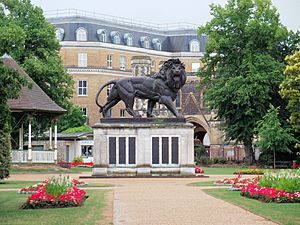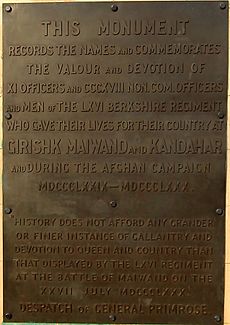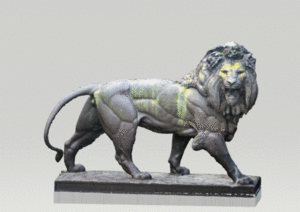Maiwand Lion facts for kids
Quick facts for kids Maiwand Lion |
|
|---|---|
 |
|
| Artist | George Blackall Simonds |
| Year | 1884 |
| Type | Sculpture |
The Maiwand Lion is a large sculpture and war memorial found in the Forbury Gardens. This is a public park in the town of Reading, England. The statue is named after the Battle of Maiwand. It was built in 1884 to remember 329 soldiers. These men were from the 66th (Berkshire) Regiment of Foot. They died during a war in Afghanistan between 1878 and 1880. Some people in Reading also call it the Forbury Lion.
Contents
The Maiwand Lion: A Brave Story
The Maiwand Lion stands tall to honor soldiers. It specifically remembers those from the 66th (Berkshire) Regiment. These soldiers fought in the Second Anglo-Afghan War. This war took place in Afghanistan from 1878 to 1880.
Remembering the Battle of Maiwand
The statue is named after the Battle of Maiwand. This battle happened on July 27, 1880. The 66th Regiment faced a much larger Afghan army. They were outnumbered by about ten to one.
About 258 of the 500 soldiers from the regiment died in this battle. Eleven of these men bravely protected their regimental flags. They fought until the very end. Even the Afghan soldiers who fought them spoke of their courage with great respect.
The famous writer Arthur Conan Doyle was inspired by this event. He based his character Dr. Watson on a real medical officer. This officer, Surgeon Major A F Preston, was injured in the battle.
Who Made the Maiwand Lion?
The artist who created the Maiwand Lion was George Blackall Simonds. He was from a well-known brewing family in Reading. His family owned Simonds' Brewery.
It took George Simonds two years to design and finish the sculpture. He studied real lions carefully. This helped him make the statue look very realistic. The Maiwand Lion is one of the biggest cast iron statues in the world.
George Simonds continued to be a successful sculptor. He later made a statue of Queen Victoria in 1887. He also created a statue of George Palmer in 1891. He stopped sculpting in 1903. Later, he became the chairman of his family's brewery business.
What Is the Lion Made Of?
The Maiwand Lion statue is made of cast iron. It is very heavy, weighing 16 tons. It was cast, or shaped, by a company called H. Young & Co. in 1886.
The statue first stood on a base made of terracotta. But this material started to crack under the lion's great weight. So, the base was replaced with stronger granite.
The base has tablets with the names of the soldiers who died. It also has a special message written on it. The entire monument is considered a very important historical structure. It is listed as a Grade II building by English Heritage.
The Lion's Local Fame
The Maiwand Lion is a well-known symbol in Reading. You can see its image on the front page of the local newspaper, the Reading Post. It also appears on the crest of the Reading Football Club. In 2016, the lion's face was even on the medal for people who finished the Reading Half Marathon race.
A local company, the Loddon Brewery, makes a beer called Forbury Lion. This shows how important the statue is to the area.




